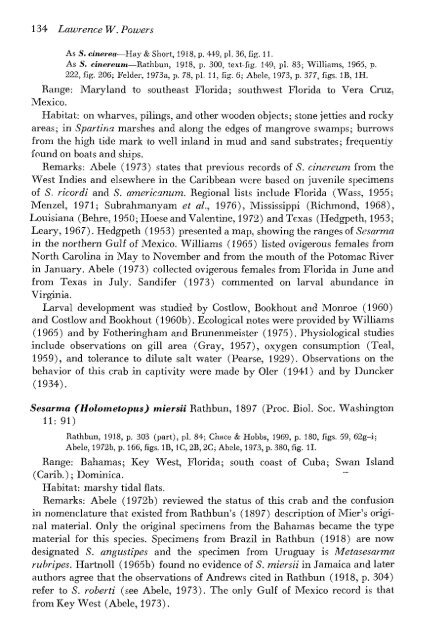You also want an ePaper? Increase the reach of your titles
YUMPU automatically turns print PDFs into web optimized ePapers that Google loves.
134 Lawrence W. Powers<br />
As S. cinei-ea—Ha,y & Short, 1918, p. 449, pi. 36, fig. 11.<br />
As S. cinereum—Rathbun, 1918, p. 300, text-fig, 149, pi. 83; Williams, 1965, p.<br />
222, fig. 206; Felder, 1973a, p. 78, pi. 11, fig. 6; Abele, 1973, p. 377, figs. IB, IH.<br />
Range: Maryland to southeast Florida; southwest Florida to Vera Cruz,<br />
Mexico.<br />
Habitat: on wharves, pilings, and other wooden objects; stone jetties and rocky<br />
areas; in Spartina marshes and along the edges of mangrove swamps; burrows<br />
from the high tide mark to well inland in mud and sand substrates; frequently<br />
found on boats and ships.<br />
Remarks: Abele (1973) states that previous records of S. cinereum from the<br />
West Indies and elsewhere in the Caribbean were based on juvenile specimens<br />
of S. ricordi and S. americanum. Regional lists include Florida (Wass, 1955;<br />
Menzel, 1971; Subrahmanyam et al., 1976), Mississippi (Richmond, 1968),<br />
Louisiana (Behre, 1950; Hoese and Valentine, 1972) and Texas (Hedgpeth, 1953;<br />
Leary, 1967). Hedgpeth (1953) presented a map, showing the ranges of Sesarma<br />
in the northern Gulf of Mexico. Williams (1965) listed ovigerous females from<br />
North Carolina in May to November and from the mouth of the Potomac River<br />
in January. Abele (1973) collected ovigerous females from Florida in June and<br />
from Texas in Julj^ Sandifer (1973) commented on larval abundance in<br />
Virginia.<br />
Larval development was studied by Costlow, Bookhout and Monroe (1960)<br />
and Costlow and Bookhout (1960b). Ecological notes were provided by Williams<br />
(1965) and by Fotheringham and Brunenmeister (1975). Physiological studies<br />
include observations on gill area (Gray, 1957), oxygen consumption (Teal,<br />
1959), and tolerance to dilute salt water (Pearse, 1929). Observations on the<br />
behavior of this crab in captivity were made by Oler (1941) and by Duncker<br />
(1934).<br />
Sesarina (Holometopus) miersii Rathbun, 1897 (Proc. Biol. Soc. Washington<br />
11: 91)<br />
Rathbun, 1918, p. 303 (part), pi. 84; Chace & Hobbs, 1969, p. 180, figs. 59, 62g-i;<br />
Abele, 1972b, p. 166, figs. IB, IC, 2B, 2C; Abele, 1973, p. 380, fig. II.<br />
Range: Bahamas; Key West, Florida; south coast of Cuba; Swan Island<br />
(Carib.); Dominica. "^<br />
Habitat: marshy tidal flats.<br />
Remarks: Abele (1972b) reviewed the status of this crab and the confusion<br />
in nomenclature that existed from Rathbun's (1897) description of Mier's original<br />
material. Only the original specimens from the Bahamas became the type<br />
material for this species. Specimens from Brazil in Rathbun (1918) are now<br />
designated S. angustipes and the specimen from Uruguay is Metasesarma<br />
ruhripes. Hartnoll (1965b) found no evidence of S. miersii in Jamaica and later<br />
authors agree that the observations of Andrews cited in Rathbun (1918, p. 304)<br />
refer to S. roberti (see Abele, 1973). The only Gulf of Mexico record is that<br />
from Key West (Abele, 1973).

















